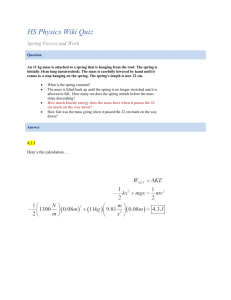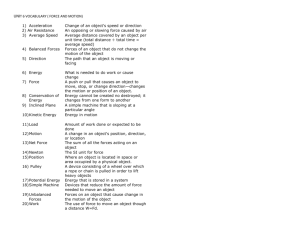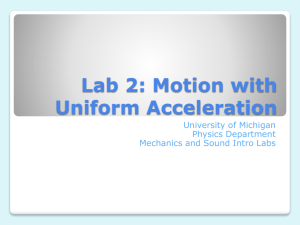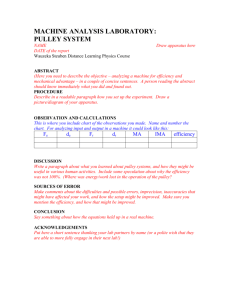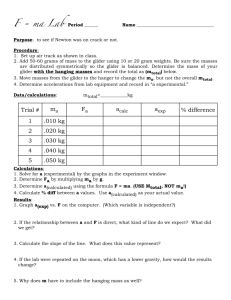5. Conservation of Mechanical Energy
advertisement
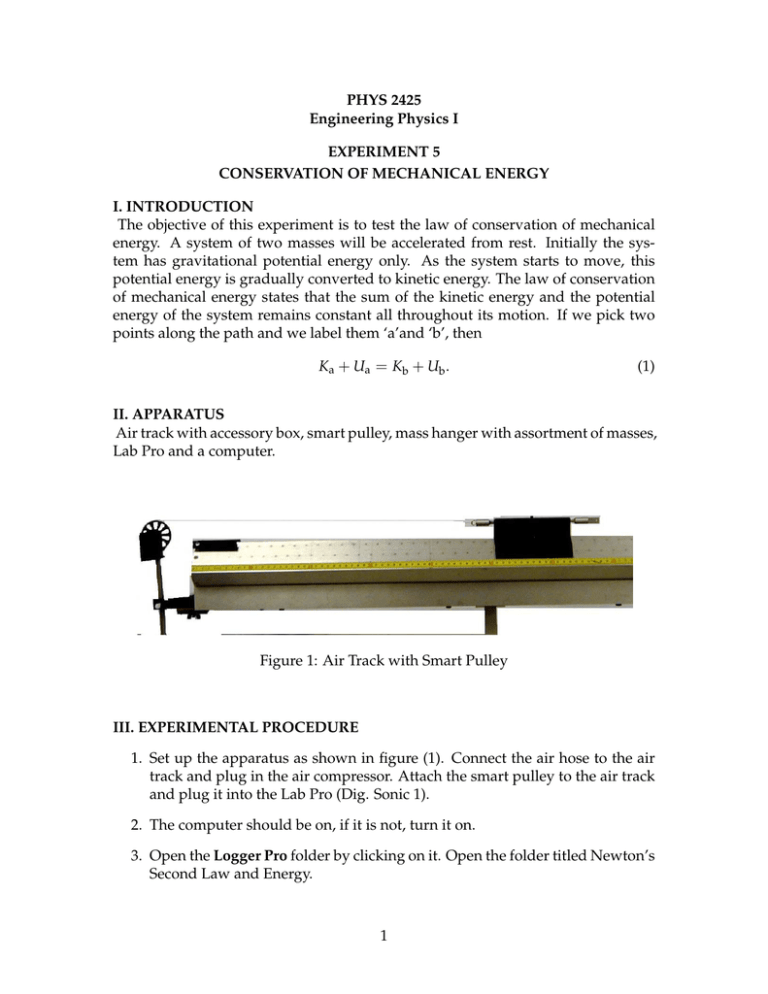
PHYS 2425 Engineering Physics I EXPERIMENT 5 CONSERVATION OF MECHANICAL ENERGY I. INTRODUCTION The objective of this experiment is to test the law of conservation of mechanical energy. A system of two masses will be accelerated from rest. Initially the system has gravitational potential energy only. As the system starts to move, this potential energy is gradually converted to kinetic energy. The law of conservation of mechanical energy states that the sum of the kinetic energy and the potential energy of the system remains constant all throughout its motion. If we pick two points along the path and we label them ‘a’and ‘b’, then Ka + Ua = Kb + Ub . (1) II. APPARATUS Air track with accessory box, smart pulley, mass hanger with assortment of masses, Lab Pro and a computer. Figure 1: Air Track with Smart Pulley III. EXPERIMENTAL PROCEDURE 1. Set up the apparatus as shown in figure (1). Connect the air hose to the air track and plug in the air compressor. Attach the smart pulley to the air track and plug it into the Lab Pro (Dig. Sonic 1). 2. The computer should be on, if it is not, turn it on. 3. Open the Logger Pro folder by clicking on it. Open the folder titled Newton’s Second Law and Energy. 1 4. Tie a string (about 1.5 meters long) to the hanging mass (see data table) and tie the other end of it to the accessory hook which fits in the top hole of the air track glider. 5. Measure the hanging mass, m, the glider mass, M using the digital balance and record the values in the data table. Dont forget to record the uncertainties also. 6. Move the glider back on the airtrack until the hanging mass is a few centimeters below the smart pulley. Click on the Collect button and wait for a Red Stop Button. Wait one second and release the glider. Watch the data table on the left of the screen and when the data reaches the bottom of the screen, click Stop. The computer will disply a data table containing velocity and distance. 7. In your data table record the velocity for every 5th line number starting with line number 5 and stopping with line number 45 (make sure this line number has been reached before the glider stopped). Every line number indicates that the smart pulley has been blocked and unblocked once (the smart pulley has rotated through one spoke and the hanging mass has fallen a distance of 0.015 m). As you can see from the data table, every 5 line numbers the hanging mass falls a distance 5 × 0.015 m = 0.075 m and it’s height decreases by that amount. The height at line number 45 will be taken as zero and so will the potential energy of the hanging mass. 8. You are finished with the experimental procedure. Turn the air track off. Leave the apparatus as it is and do sample calculations to make sure your data are in agreement with the law of conservation of mechanical energy. IV. ANALYSIS 1. Calculate the kinetic energy of the two masses K= 1 ( m + M ) v2 2 (2) and the potential energy of the hanging mass U = mgh (3) and record the values obtained in the data table. Note that one of these is increasing and the other is decreasing. 2. Calculate the total energy E = K + U and enter it in the data table. 3. Calculate ∆K and ∆U between two consecutive locations and enter them in the data table. These are the changes in K and U respectively. The law of conservation of mechanical energy states that ∆K = −∆U. 2 (4) Is this borne out by your calculations? Find the ∆K and the corresponding ∆U which differ from each other by the largest amount and calculate the percent difference between them Max % diff. = |∆K | − |∆U | × 100. |∆K | + |∆U | 2 (5) 4. Calculate the percent difference between the initial and the final mechanical energies E − Ei × 100. (6) % diff. = f Ef + Ei 2 5. On the same set of axes, plot the kinetic energy, the potential energy and the total energy on the vertical axis and height on the horizontal axis. 6. Write a concultion. Comment on the accuracy of this experiment. Are your data consistent with the law of conservation of mechanical energy? What do you think are the two most important sources of error? Experiment (5) Data Table Hanging Mass, m ± δm = Glider Mass, M ± δM = Experiment (5) Data Table Kinetic Line No. Velocity Height v h Total Energy Energy (m) 1 2 (m + (J) 5 0.600 10 0.525 15 0.450 20 0.375 25 0.300 30 0.225 35 0.150 40 0.075 45 0.000 Energy E = K+U K= (m/s) Potential M ) v2 U = mgh (J) (J) 0.000 Experiment (5) Data Table Line No. Kinetic Potential Energy Energy ∆K = Ki − Ki−5 ∆U = Ui − Ui−5 K U (J) (J) (J) (J) 5 XX 45 XX XX XX XX XX XX XX XX XX XX XX XX 40 XX XX XX 35 XX XX XX 30 XX XX XX 25 XX XX XX 20 XX XX XX 15 XX XX XX 10 XX XX XX 0.000 5
